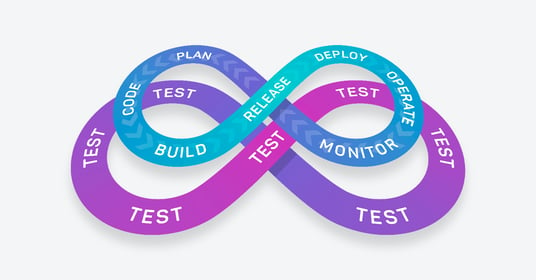Get a Free Trial
Creating, executing, and maintaining reliable tests has never been easier.
CI/CD are closely connected to DevOps adoption and enabling faster software development. Essentially, DevOps is the map that guides the shift to integrated development and operations teams, while CI/CD/CD are the pathways that allow teams to reach their destination through ongoing automation and data gathering. Each component covers a particular aspect of the software development lifecycle:
- Continuous integration (CI) focuses on blending the software work products of individual developers together into a repository. This can be done several times a day, with the primary goal of enabling early detection of integration bugs while also allowing for tighter cohesion and more development collaboration.
- Continuous delivery (CD) aims to minimize the friction points that are inherent in the deployment or release processes. Typically, a team's implementation involves automating each of the steps for build deployments so that a safe code release can be done at any moment in time.
- Continuous deployment (CD) is a higher degree of automation, in which a build/deployment occurs automatically whenever a major change is made to the code.
Whether adopted simultaneously, sequentially, or piecemeal, CI/CD/CD can significantly streamline software development for faster, smoother release cycles.
Embracing Rapid Development, Not Risky Development
But there’s a risk to more automated pipelines: introducing bugs into production. If testing isn’t considered a core component of CI/CD enablement, development teams risk establishing flawed pipelines that produce flawed software. The challenge is integrating testing in a way that ensures quality, but doesn’t slow down deployments.
Optimize for Software Testing
Establishing a quality-centered CI/CD pipeline starts with planning an efficient test automation strategy. Ideally, testing provides an important checkpoint for code as it moves through an automated pipeline, ensuring that bugs are caught as early as possible while minimizing the need for human intervention. But if tests aren’t focused on the right aspects of quality, CI/CD pipelines become fragile and high maintenance. By focusing tests on the most important aspects of risk, quality engineering teams can keep the entire development organization focused on delivering new features.
In a similar vein, many CI/CD pipelines become difficult to troubleshoot because specific environments are hard to recreate, limiting the team’s ability to reproduce and resolve bugs. Again, planning ahead saves everyone time and effort. Developers and QA teams should collaborate to ensure that every testing environment can be reliably recreated.
Establish Testing Observability
Simply catching bugs is only the first part of the quality equation. To fully integrate testing into their CI/CD, QA and development teams need processes in place to ensure that test results and testing metrics are routinely reviewed. When it comes to rectifying high-priority bugs, speed and clear communication are critical. The longer a development team spends trying to figure out what tests failed and why they failed, the longer it takes to resolve the issue, stalling the entire CI/CD pipeline. Establishing processes around sharing context, assigning responsibility, and re-testing fixes ensures that CI/CD pipelines operate smoothly.
More broadly, development teams adopting CI/CD need to plan to review critical quality metrics like test coverage. If testing doesn’t evolve with the product, tests embedded within the CI/CD pipeline ultimately become meaningless as more bugs slip into production. Regular discussions around test coverage and testing priorities help establish a culture of quality that enables fast and confident automated pipelines.
Manage and Minimize Flakiness
The fact of the matter is that tests will break, become flaky, and potentially create issues in CI/CD. More frequent releases mean that the product evolves more quickly, and that even well-prioritized, highly efficient testing strategies will become outdated. Once tests stop functioning, many QA teams find themselves overwhelmed by test maintenance, ultimately creating a block for CI/CD pipelines. Advances like autohealing tests - which use AI and machine intelligence to evolve with the product - can drastically reduce the amount of rote work required for test maintenance, but QA teams should still have plans in place to check any automatic updates, isolate flaky tests so they don’t impact the rest of the CI/CD flow, and dedicate time to ensuring that tests are reliable.
Automated for Speed, Optimized for Quality
Choosing between speed and quality isn’t feasible in a world where B2B and B2C consumers expect delightful digital experiences and consistent innovation. As more organizations seek to streamline their development processes through CI/CD adoption, it’s critical that they consider how to implement scalable and sustainable testing. Otherwise, CI/CD pipelines become fragile and riddled with risk. For successful CI/CD adoption, quality and software testing must be a core competency.
Start embedding adaptable, intelligent testing in your CI/CD pipeline today with mabl’s 14-day free trial.






